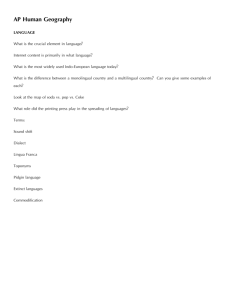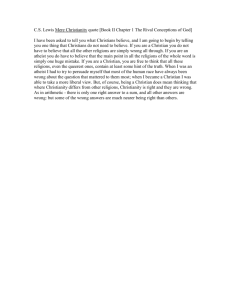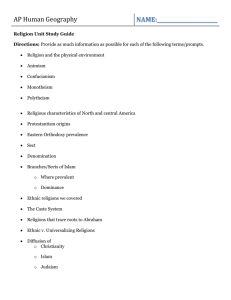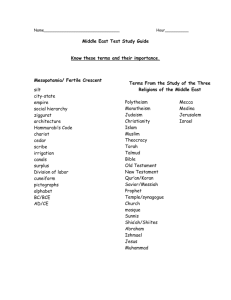Religion Overview
advertisement
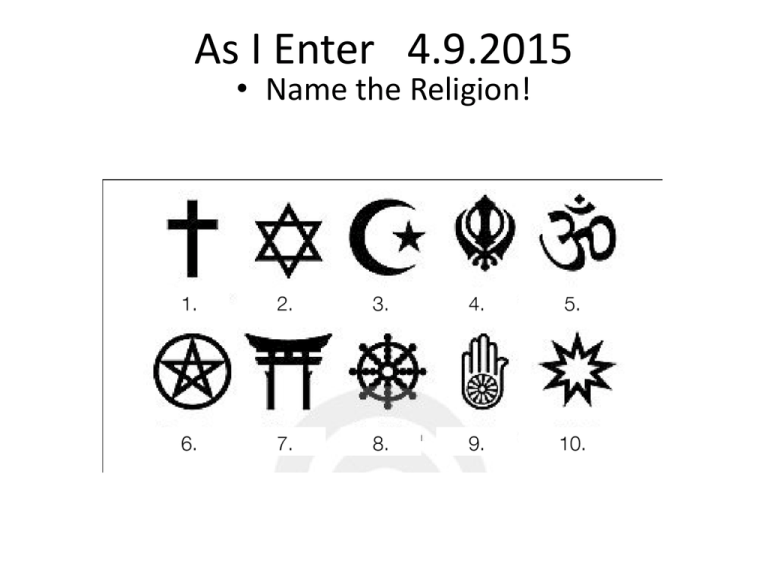
As I Enter 4.9.2015 • Name the Religion! Agenda: • 1. The Language Test • 2. Reviews – schedule update! • 3. Schedule for the next week – Today – Notes on Religion – Tomorrow - • 4. Religion Intro • 5. Religion – Overview notes – Diffusion notes – Diffusion activity Pre-Grid Times • On Monday April 13th and Friday April 17th students will be pre-gridding for their test(s). • On these two days I will be in room D111 from 7:00 am- 3:00 pm as a Pre-Grid "Open House". • • • • • 1. Before and After School 2. Lunch 3. Study Hall 4. ACCESS 5. PE • They will not need more than 30 minutes to complete this activity, however, we cannot house all students during ACCESS. So, please share this with your students. I will be prepared to write passes for students back to class and will monitor that they are using their time wisely. Religion Overview Religion is… “a system of beliefs and practices that attempts to order life in terms of culturally perceived ultimate priorities.” - Stoddard and Prorak “perceived ultimate priorities” often translate into a list of things a follower “should” do and ways a follower “should” behave. The Paradox of Religion • All religions hold peace as the highest value • Loving the enemy is common to all religions • Geographers are concerned with the distribution of religion and the potential for conflict. • Religion in many nonwestern areas makes up the culture. – Religious cultural landscapes-churches, temples, mosques, shrines, cemeteries, statues, veils, turbans, beards and scars – In LDCs Religion is a binding force – guides routine Key Characteristics of Religion • Set of doctrines or beliefs relating to a god or gods. • Structure or hierarchy of officials • Rituals for: – – – – – – Birth Death Reaching adulthood Marriage Prayer Routine services on a Fri, Sat. or Sun. • Impact of religioncalendars, holidays, architecture, place names, slogans on coins or flags. • Positive impact – Education – Medicine and health care – The arts • Negative impact – – – – Blocked scientific study Oppression Supported imperialism Kept women inferior Classifications of Religions • • • • Monotheistic-belief in 1 god Polytheistic-belief in many Animistic-objects have spirits-trees, mountains, rivers Cultural religion-limited to a national culture or a single region-Shinto, Daoism, etc. Classifications of Religions • Universalizing religions – religions that actively seek converts because members believe they offer belief systems of universal appropriateness and appeal. (Christianity) – Global • Ethnic religions – religions whose adherents are born into the faith and whose members do not actively seek converts. (Hinduism) – Local Universalizing • 3 Main – Christianity, Islam, Buddhism • Branches-a large and fundamental division within a religion– EX. Christianity - Catholic, Protestant and Orthodox • Denomination-a division or a branch that unites a number of local congregations into a single administrative body– EX. Christianity - Baptist, Lutheran, Methodist • Sect-has several meanings- A relatively small group that broke away from an bigger group or A religious denomination-such – EX. Islam – Sunni, Shia – EX. Christianity – Baptist – Westboro Baptist Church Ethnic • 1 main (6 other) – Hinduism – 900 million (we will cover this one extensively) • • • • • Chinese Traditional (Folk- Taoism, Confucianism) Asian and African Primal indigenous (Shamanism) Juchte – Ask me about this one! Spiritism Judaism (we will go through this one individually) Western Hemisphere • • • • 90% of West is Christian 5% other, 5% nonreligious Latin America 93% Catholic, N. America 29% Among Protestants in the US, Baptists the largest, then Methodists, Pentecostal and Lutheran • Catholics in US concentrated in NE and SW Wrap up… • What is the difference between a universalizing religion and an ethnic religion? • Reminder: – AP Exam sign up – next week. Diffusion of Religions… • Activity – Where are they found?



